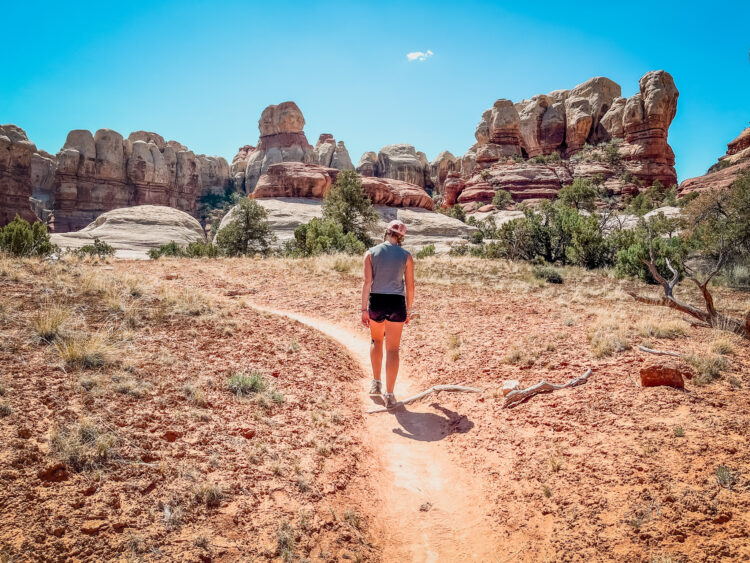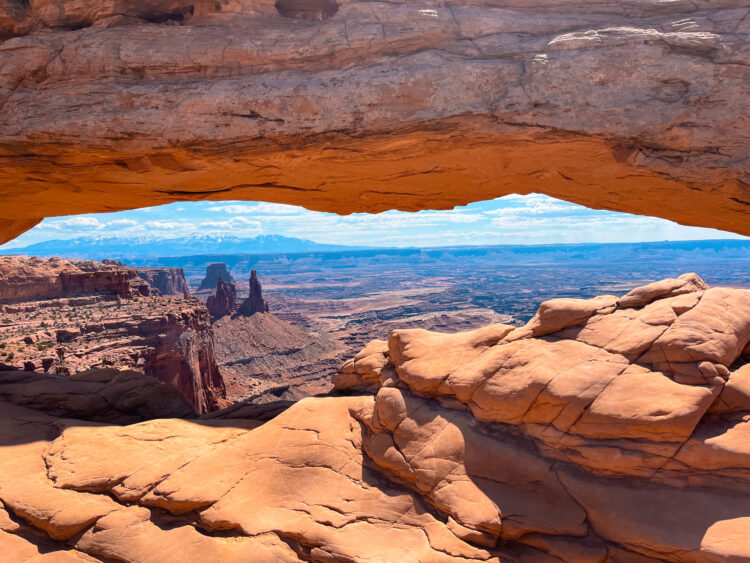Grab your pack – it’s time to hit the trail with these day hike essentials.
Whether you are a beginner hiker, or an experienced hiker looking for a list of what to pack for day hiking, we’ve got you covered! This is exactly the list of things we take with us when we go day hiking during the warm season months with some options for colder weather.
As a family, we’ve hiked countless miles on day hikes and have tested lots of gear. We don’t think you need the most expensive, fancy gear, but buying quality gear that lasts is always best.
Since we are a family of 5 with teens and a tween, packing for even a short hike can take forever. Simply print this list, pass it to your family members and you’ll be out the door in no time. If you’re missing something on the list, don’t sweat it – scroll down for links on where you can grab these things to pack for hiking.
You can also find specific ideas the Best Hiking Gear for Kids.
As an Amazon Affiliate, I may receive compensation when you purchase something through a link on this page.
Exactly What to Pack for Day Hiking
Use this day hike pack list as a starting point for your next hike. Depending on the season and the length of your hike you may want to add or subtract from the list as needed. If you are wondering what to bring on a short hike and whether you really need everything listed below, remember that emergencies can happen even on short hikes, so while it may feel like overkill to bring a first aid kit and a lighter on a 3-hour hike, most of the items are lightweight and worth bringing so you are ready for the unexpected.
This winter we were about 2 miles into a trail when my teenage son fell and opened up his knee. We were grateful for our emergency supplies to help get him safely out of the woods.
Print this day hike checklist by clicking on the list below
- Hiking Boots
- Day Hiking Backpack
- Clothing Layers
- Rain and Wind Layers
- Food
- Water
- Navigation
- Flashlight or Headlamp
- Sun Protection
- Repair Kit
- First Aid Kit
- Cell Phone
- Small Knife
- Emergency kit – whistle, cord, firestarter, mirror
- Hiking Poles (optional)
Looking for a complete hiking planner, trail log and packing list? Check out our items on our Etsy Shop.
Packing List for Day Hike: Details of Essential Items
Read below for more details on what to pack for day hiking and where you can find our favorite items. This is exactly what we pack when we hike. Out kids, each carry their own backpacks (although we sometimes carry water and food for our 10 year old). This includes all their layers, food, water, and any personal items.
There are a few items on the list that you only need one of (first aid kit, navigation, etc) so you can divide up the gear between the group. It’s worth doing a quick check at the beginning of each hike to make sure you have everything you need.

Day Hiking Backpack
Each person will need their own day hiking pack. The best day pack for hiking will be lightweight, sturdy, and fit comfortably. It’s important that the day pack is big enough to carry plenty of water and layers, but small enough that it isn’t bulky.
One feature we like is a place to hold a water bottle on the outside of the pack (or a place to put a hydration system inside the pack). We also like bungee straps on the outside so we can quickly store layers until the next stop next and can stow them properly. Some type of outside storage is helpful as well if something gets wet and we want to keep it outside the pack.
My teens have used a few packs as they’ve gotten bigger. For some hikes, they use the Venture Pal Pack but they have recently upgraded and Hadley uses an Osprey 20.
Freja (10 years old) recently got the Northface Borealis. This bag is slightly big for her but will grow with her over the next year and should fit well (she is a very tall 10-year-old).
Lately, I’ve been carrying my much larger backpack to carry extra layers during winter hikes, but I just got an Osprey Tempest 30L and I’m so excited to take it with me this summer as a travel and hiking pack.
See The Best Day Pack for Hiking
Hiking Boots
The next thing to think about after you have your day pack is what is the best footwear for day hikes. Depending on the type of trail, you can either wear full hiking boots with ankle support, sneaker-style hiking boots, sneakers, or even hiking sandals. If the trail has lots of roots and rocks, you will want extra support. On the other hand, if the trail is flat, with water crossings, you might want to consider hiking sandals.
This summer Freja hiked most of the trails in these Keens.
You should look for comfortable hiking shoes that are waterproof. I like to wear hiking-style sneakers with some ankle support that are also lightweight mostly because they are easier to pack. This is what I’m using at the moment – Quadra II hiking boots.
No matter what shoes you decide to use, you should make sure that you break them in before your hike by wearing them around the house and on short walks. Hiking shoes are notorious for blisters until they are broken in.
See 7 Hiking Boots Under $100.

Clothing Layers
The next thing on your list of what to pack for a day hike is clothing. What you wear on your hike will go a long way to keeping you comfortable, dry, and warm. It’s important to select fabrics that breathe, are quick-drying, and wick moisture away from your skin. You can easily spend a lot of money on top-end clothing, but there are also less expensive options.
You should avoid cotton when possible. Jeans, sweatpants, and cotton t-shirts will all get wet and hold the water making you uncomfortable and potentially cold when you stop moving. Can you do a 2 hour day hike in a cotton t-shirt, of course, but you should also have some warmer layers you can swap out if you get chilled.
Depending on where and when we’re hiking, we usually wear a base layer. In the summer, this can be a t-shirt and shorts. On top of these layers, we each bring a long-sleeved layer and a pair of pants. Dave and I prefer a lightweight fleece pair of pants, while both my daughters like to wear leggings, and my son wears more traditional hiking pants.
If we’re hiking in the fall or winter, we also pack a puffy jacket layer or a fleece coat for warmth. This usually packs small so is an easy thing to bring along.
Finally, don’t forget hiking socks as these go a long way to keeping you comfortable on the trail. I really like these socks and find they work well for many seasons.
Rain and Wind Layers
The next layer to add is a wind and rain layer. This layer becomes useful on the summit, when the wind picks up, or of course if it rains. My kids hate hiking in rain pants, so we often wear quick-dry pants or leggings and bring the rain pants for when we stop to keep warm.
For day hikes, I prefer a lightweight jacket that I can put layers underneath. These tend to pack easier and give you more options than some of the more heavy-duty raincoats.

Food
It’s important to pack plenty of food for a day hike. You should plan on at least 200 calories per hour. We usually bring a big lunch with an assortment of snacks. Our favorite snacks are fruits, vegetables, nuts, and some chocolate. For lunch, we often bring peanut butter and jelly or make a wrap with veggies, hummus, and cheese. Always pack 2-3 more things than you think you’ll eat in case the hike takes a little longer.
I put together this list of food for the car, but many of the snack ideas are also excellent choices for hiking: The 100 Best Road Trip Snacks For Kids and Adults
Water
It’s important to have enough water on your hike. You should plan to bring about a 1/2 liter for every hour you plan to be hiking. In the hot, summer months, you should plan to bring even more water (at least 3 liters).
There are several options for carrying that much water. You can bring large water bottles. We like Nalgene bottles since they are light and durable. You can also bring a water hydration system. Hadley uses this bag and water bladder often on short hikes.
A final option if you are out for a long day, is to bring a water filtration system. This is helpful if you are hiking in a place that doesn’t have clean water available but does have natural water that can be treated. We recently each got life straws and plan to carry them with us on most day hikes.
Read more about the Best Ways to Carry Water While Hiking
Navigation
When you’re heading out on the trail, it’s important to know where you’re going and how to get home. For some reason, this is an easy thing to overlook when you are packing for a hiking trip. Some trails have excellent signage and are well marked, but it’s important to also know where you are going in case you get off route. If you are counting on navigating online with your cell phone, it is also likely you won’t have coverage during your day hike.
You should always download a map of your hiking trail and take a photo of the trail map (if there is one at the start of the hike). I always make my kids look at the map and point out the trail so everyone knows where we’re going. You can download hiking maps from the AllTrails app. For many day hikes, this might be enough, however, if the trail is at all complicated or not well marked you should always bring a paper trail map or a hiking book with a map.
A basic compass is helpful as well (just make sure you know how to use the compass).

Flashlight or Headlamp
We’ve done many day hikes that simply take longer than expected and we end up hiking out in the dark. You should always have some type of light source so you are able to hike out safely. You can sometimes use your phone light in an emergency, but having a headlamp allows you to keep your hands free and won’t drain your phone battery.
See our favorite headlamps for kids.
Sun Protection
No matter what time of year you’re hiking, you should always have some sort of sun protection. This includes sunscreen, hats, and lightweight clothing to cover up in the heat and sun. Many hikes lack shade so you will have nowhere to go if you start to get burnt.
See the Best Hiking Hat: Women, Men and Kids
Repair Kit
Having a very basic repair kit is helpful even on day hikes. You can purchase simple repair kits or for short hikes, I often bring a lighter wrapped in duct tape. Duct tape makes an excellent short-term repair solution for most problems!
First Aid Kit
A first aid kit is a must on a day hike. We have several small first aid kits that we try to restock as we go through supplies. The kit should include basic wound care, emergency supplies, and pain killer at a minimum. You can buy a small kit like this one, or if you’re planning to do a longer hike where you are far from help, you may want to bring a larger kit.
In addition to carrying the kit, it’s important to know what’s in it and how to use the basics. Taking a first aid and CPR course is a good idea for anyone, but even reviewing the booklet that comes in the first aid kit before going hiking is a good start.

Cell Phone
While you can’t count on your cell phone getting coverage – there are a lot of reasons you might want your phone. I currently have an iPhone 11 and use it to take photos often on hikes when I don’t want to carry my larger camera. I also like to download the hiking map on my phone to use as navigation, and while you can’t count on it, many hikes do have cell coverage and you could call for help if needed. I also bring a small cell phone dry bag in case it starts to rain.
Small Knife
A small knife may already be part of an emergency kit, but having a small multitool is helpful in many ways. The most common way we use a small knife is for cutting up food on the trail. A knife will also be invaluable if you need to administer first aid on the trail. My kids each carry a Swiss army knife in their pack.
Emergency kit – whistle, cord, firestarter, mirror
In addition to first aid supplies, there are a few other items that can be put into an emergency kit. We actually keep all of our emergency supplies together. You should have some way to make noise such as a whistle, some small cord to help with first aid or other emergencies, or something to start a fire such as a lighter and a mirror. All these items are lightweight and small to put in the bottom of your bag.
This small kit may be a bit of an overkill for a day hike but does have the essentials all in a carrying case.
Hiking Poles (optional)
Hiking poles are a great optional item to have on your next day’s hike, and we almost always carry a pair or two. They are helpful for balance on the way down and help with knee issues. You should look for hiking poles that are lightweight and sturdy. There are lots of options at reasonable prices.

What did I miss on our ‘What to Pack for Day Hiking’ list? Drop a comment with your favorite gear!
You Might Also Like:








Pingback:9 Best Ways to Find Hiking Trails Near Me - Chasing ADVNTR
Pingback:7 Best Hiking Boots Under $100 - Chasing ADVNTR